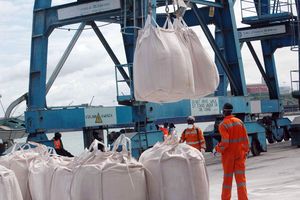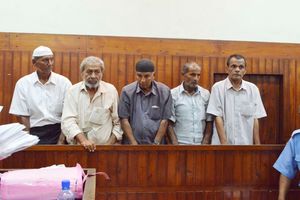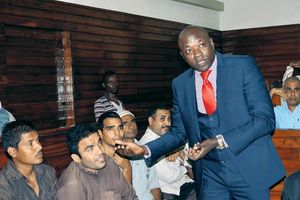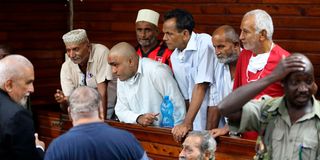
Seven foreigners in a Mombasa court on February 22, 2023 during the hearing of a drug trafficking case. The High Court has acquitted them of all charges and set them free.
A case involving Sh1.3 billion worth of heroin found aboard a ship in Mombasa has collapsed after the High Court cited a bungled investigation, confusion within the Kenya Navy and the illegal destruction of evidence.
As a result, six Pakistani nationals and one Iranian, who had been sentenced to life imprisonment for drug trafficking, have been released. The High Court found that the prosecution’s case was severely compromised due to procedural and legal shortcomings.
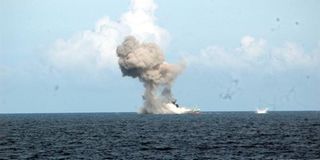
The MV Al Noor explodes after it was blown up by Kenya Navy on the President’s orders on August 29, 2014.
The narcotics were discovered in 2014 on the cargo deck of the vessel AMIN DARYA, also known as MV Al Noor, which was seized in the Indian Ocean. The drugs were later destroyed under strict orders from then President Uhuru Kenyatta.
Yousuf Yaqoob, Yakoob Ibrahim, Saleem Muhammad, Bhatti Abdul Ghafour, Baksh Moula, Pak Abdolghaffer and Muhammed Saleh were convicted and sentenced to life imprisonment by a magistrate’s court in 2023.
However, following a High Court review, they have now been acquitted.
In a 98-page judgment, Justice Wendy Micheni exposed serious legal and procedural flaws that fundamentally undermined the prosecution’s case. Central to her findings was the failure to establish the vessel’s nationality and its exact location at the time of interception, which are key elements in maritime law.
“The prosecution did not prove that the point of interception was within the territorial waters and the nationality of the vessel could not be established,” the judge stated, emphasising the importance of jurisdiction in such cases.
One prosecution witness who inspected the vessel’s GPS noted it was non-functional. The court also found that navy officers who intercepted the ship could not present their GPS coordinates or logs of communication with the ship’s crew as their testimonies were inconsistent.
“Therefore, the exact point of interception was not proved. The evidence of the three Kenya Navy officers involved at the interception of the vessel is at variance when it comes to where exactly it occurred,” said the judge.
“That certainly was not within the 12-nautical mile territorial sea but within the 220-nautical mile Kenya’s Exclusive Economic Zone.”
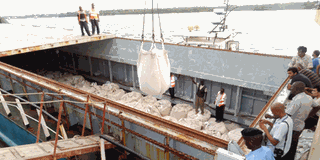
Port workers, security officers and crew members supervise the offloading of cargo suspected to be drugs from the vessel MV Al Noor at the port of Mombasa on July 3, 2014.
The vessel bore two names, had no national flag and carried conflicting documents. There was no verified owner or shipping agent. And although the interception was permitted under international maritime conventions, Justice Micheni noted that the search and seizure process did not comply with Kenyan law. Of particular concern was the recovery of the first suspicious package allegedly containing heroin.
Justice Micheni expressed concern that none of the witnesses could definitively say who discovered it or describe the circumstances. “They kept passing the buck,” the judge remarked, highlighting the lack of clarity and transparency in the evidence.
The package was reportedly found several days after the search began. By that time, numerous people, including crew members, search teams, crane operators, and a marine inspector, had boarded the ship and were repackaging its cement cargo. The package was lying openly on the cargo deck; it was not hidden or camouflaged.
“It could be sheer luck, but the contradictions in the recovering officer's evidence raised a definite red flag in the evidence,” the judge noted.
The captain’s alleged confession, admitting the presence of drugs, was also dismissed. Justice Micheni found that it had been obtained under duress, following the mysterious death of a crew member during the night.
Also, no search warrant had been obtained before the ship was boarded and searched, another procedural lapse that further weakened the case. Legal protocols for conducting such searches were blatantly ignored.
“Many people were aboard the vessel, and the searches continued late into the night,” the judge said.
A welder who testified said he had seen “old cuts and welding” on the ship’s deck before the drugs were allegedly retrieved. This directly contradicted the prosecution’s claim that the drugs were hidden and only accessed after the vessel docked.
“Unfortunately, the vessel was destroyed before the defence had an opportunity to examine it or challenge these claims,” Justice Micheni said, noting that this significantly undermined the accused's right to a fair trial.
The timeline inconsistencies further cast doubt on the prosecution’s case. The accused were presented in court on July 9, 2014, the same day more drugs were allegedly recovered from the ship’s deck yet they were not present during this search, raising questions about the integrity and custody of the vessel at the time.
The judge challenged the logic behind such charges, noting that even without delving into legal technicalities, it was worth questioning what transpired between August 2 and 8, 2014.
“During this period, the ship was under constant guard by Kenya Navy officers and Maritime Police Unit and effectively a crime scene. Can we logically say the appellants were trafficking drugs at the crime scene? Again no,” she said.
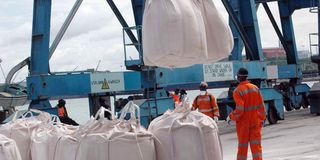
Port workers, security officers and crew members supervise the offloading of cargo suspected to be drugs from the vessel MV Amin Darya alias 'Al Noor' in July 2014.
The vessel was intercepted on August 1, 2014, and steered to Mtongwe anchorage by one officer before being moved to Berth No 8 by another.
“So if there was any movement at all, these two (Kenya Navy officers and Maritime Police Unit) would be the culprits, not those under arrest. The conveying may have been before the ship docked or before the interception. That is when the right to visit checks in. At the anchorage, we may talk of possession but definitely not transporting,” the judge said.
This reasoning was reinforced by a glaring discrepancy in the charge sheet, which claimed that the suspects trafficked drugs between July 2 and July 18, 2014 at Kilindini Port’s Berth Number 8 yet the ship had not even docked there at the time.
Another critical inconsistency concerned the amount and location of the heroin. The charge sheet stated that 377.224 kilogrammes of solid heroin, 33,200 litres of liquid heroin, and 2,400 litres of heroin-mixed diesel were recovered from the cargo deck.
But witness testimony confirmed that only 994 grammes were found in that area.
The rest was allegedly retrieved from ballast and diesel tanks, which were not mentioned in the charge sheet. This raised significant questions about the integrity of the evidence.
Furthermore, forensic analysis revealed heroin in only trace amounts, 0.19g per 100ml in one water sample, 0.17g in another, and none at all in the diesel.
Despite these minimal amounts, the prosecution treated the entire liquid volume as heroin, vastly inflating both the quantity and its street value.
“If I dissolve 5g of sugar in a litre of water, can we say the entire litre is sugar? Of course not. That exaggeration affected the valuation and ultimately, the harsh sentences imposed,” said Justice Micheni.
She also hinted at possible external interference. “It appears someone was calling the shots. That’s the only way to explain why all procedural rules were ignored,” she said, suggesting pressure from a powerful person.
Justice Micheni cautioned against allowing outside forces to override the rule of law saying, “We cannot abandon our legal standards and say, ‘come what may, damn the consequences’.”
In conclusion, the judge ruled that the prosecution’s case was flawed both in its substance and its process. Numerous breaches of law and inconsistencies rendered it impossible to affirm that the accused had received a fair trial.
The seven men were acquitted and set free.



